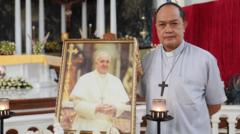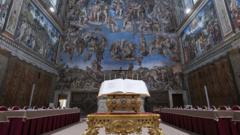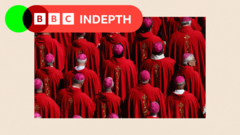On May 7, 2025, the Vatican is set to witness its first papal conclave in over a decade following the passing of Pope Francis on April 21. The crucial event kicks off after a morning Mass at St. Peter's Basilica, with cardinals processing to the iconic Sistine Chapel at 4:30 p.m. local time. This moment marks a pivotal point in Catholic leadership, where only the 133 cardinal electors under 80 years old will remain inside the chapel, following the master of pontifical liturgical celebrations' directive: “extra omnes”—meaning everyone else must exit.
The Countdown to a New Pope: Insights into the Conclave Process

The Countdown to a New Pope: Insights into the Conclave Process
As the Vatican prepares for a significant transition, the procedures and protocols for electing a new pope unfold with a rich history and strict rules.
Once the doors close, the cardinal electors are bound to the confines of the Vatican, with only limited breaks for meals and sleep. This privacy is intentionally designed to ensure a focused atmosphere as they work toward a unified decision on the next pope. To maintain secrecy, communications with the outside world via phones, internet, or television are strictly forbidden.
Discussions among the cardinals have been bubbling since the death of Pope Francis. These conversations have explored not only the plans for his funeral but also the pressing challenges facing the Church today. Typically, a conclave is expected to commence within 15 to 20 days of the pope’s demise, and this conclave is appropriately scheduled for 16 days post-Francis' passing, allowing adequate time for various preparations.
Such preparations have included closing the Sistine Chapel to visitors and setting up specialized equipment to incinerate ballots after voting, ensuring no trace of the voting process remains once a new leader has been selected. The upcoming conclave not only represents a moment of transition but also embodies centuries of tradition that reflect the heart of the Catholic Church.
Discussions among the cardinals have been bubbling since the death of Pope Francis. These conversations have explored not only the plans for his funeral but also the pressing challenges facing the Church today. Typically, a conclave is expected to commence within 15 to 20 days of the pope’s demise, and this conclave is appropriately scheduled for 16 days post-Francis' passing, allowing adequate time for various preparations.
Such preparations have included closing the Sistine Chapel to visitors and setting up specialized equipment to incinerate ballots after voting, ensuring no trace of the voting process remains once a new leader has been selected. The upcoming conclave not only represents a moment of transition but also embodies centuries of tradition that reflect the heart of the Catholic Church.





















